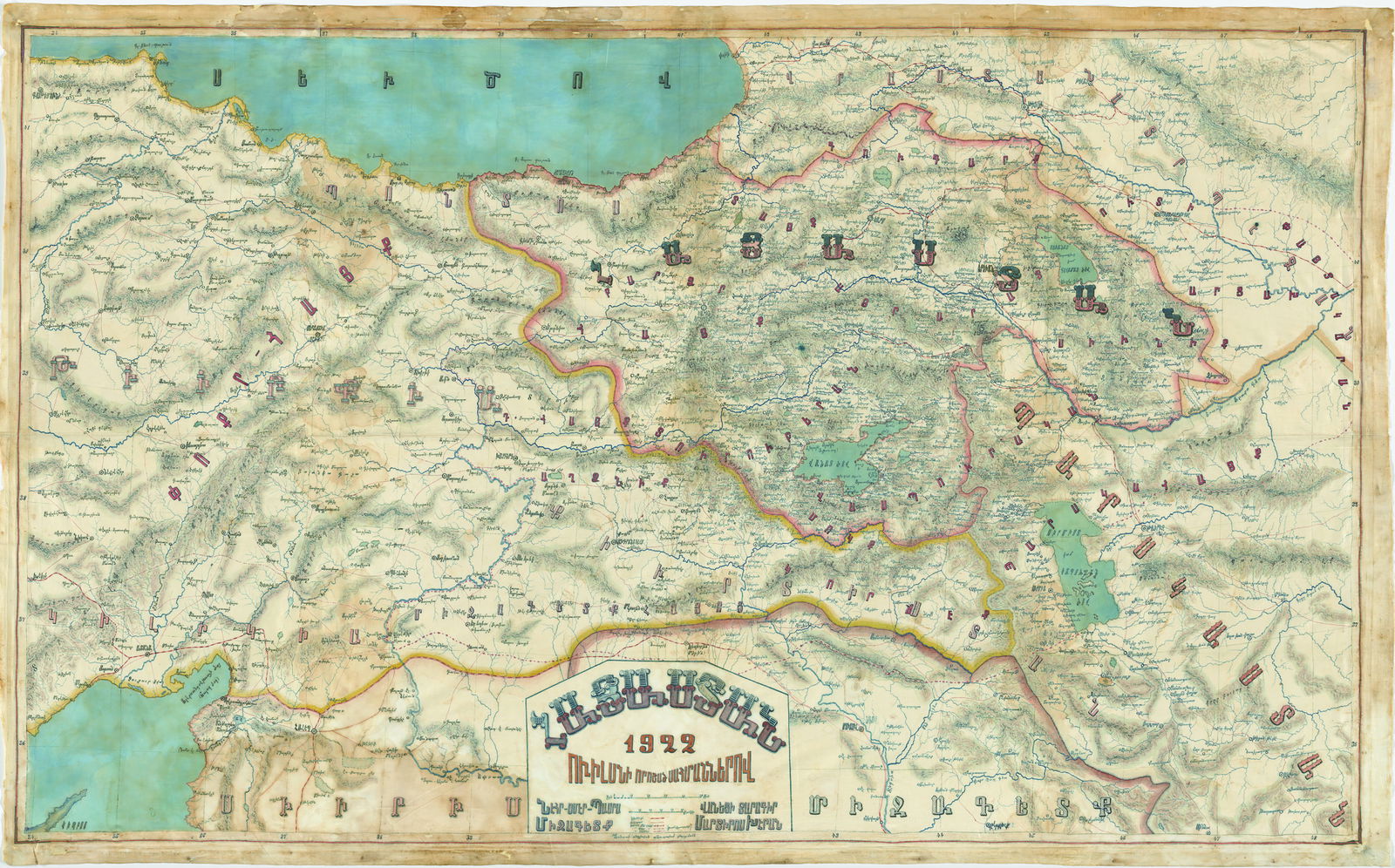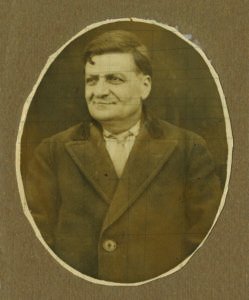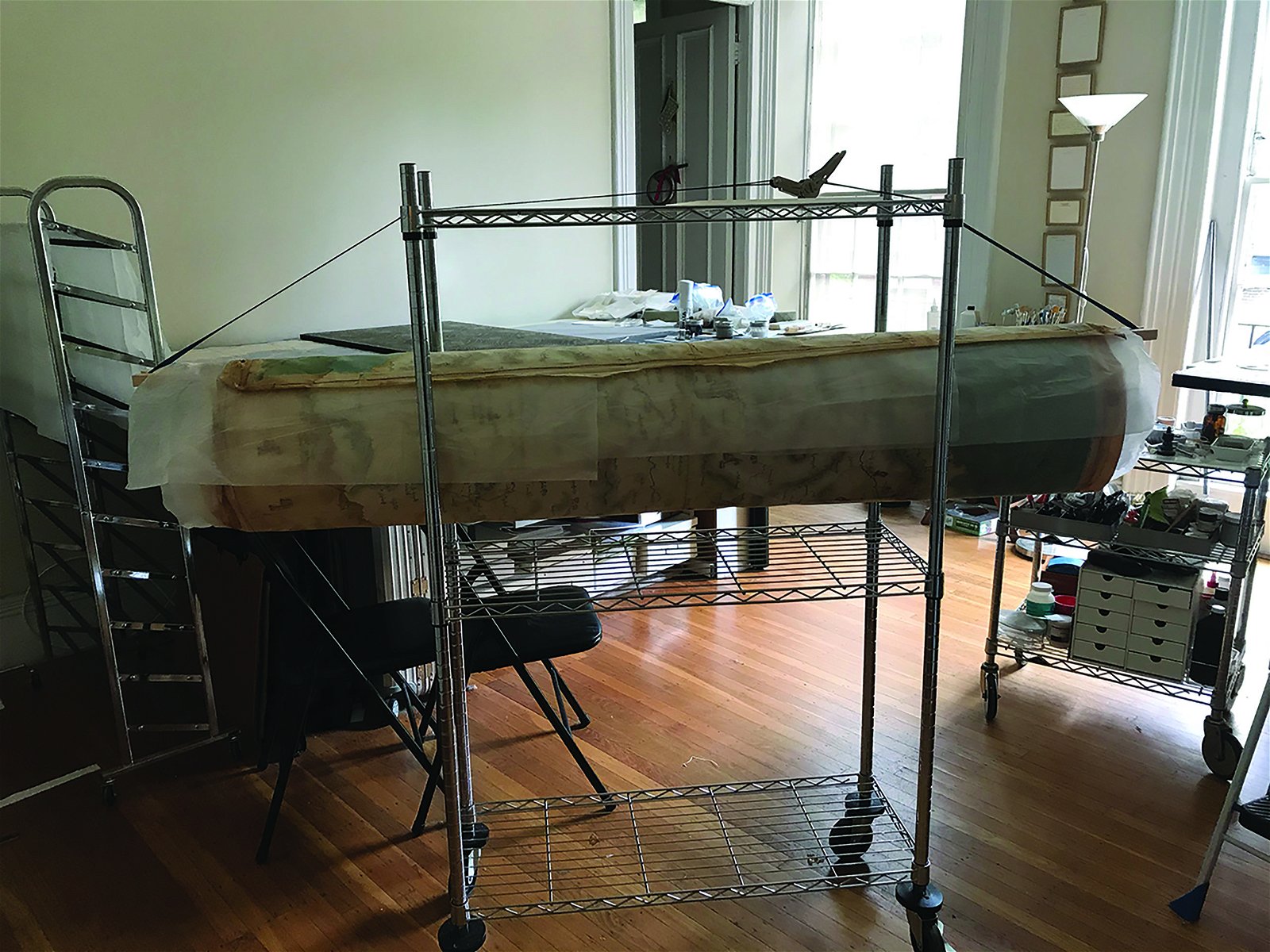
For years, every time I was in the fourth floor conference room in the Hairenik building in Watertown, Massachusetts, I would stare at a huge map on the back wall. The 5’ x 8’ map was hand-drawn by Mardiros Kheranian in 1922. Those of us fortunate to have seen this map could not help but be drawn to it and be transported to the many Armenian villages it identified. Kheranian’s map is even more of a cultural and artistic treasure in a world where the Turkish government has attempted to wipe the names of these villages from modern maps.

Kheranian was born in the region of Van and lived most of his life in Aykestan, a neighborhood just outside the city walls of Van. He was a cartographer and teacher at the famed Armenian monastery of Varakavank. He participated in the defense of Van in 1915 and, after the fall of Van in 1918, he fled south and took refuge in Syria, where he continued to create maps of Armenia. Others in his family fled to Yerevan, to France and to the US.
We do not know the exact number of maps he produced during those years, but several others are accounted for. These include a 37 x 56 inch map of the defense of Van city which is displayed at the National Museum in Yerevan and reproduced in “The Armenian Highland: Western Armenia and the First Armenian Republic of 1918,” a book written 97 years later by his great-nephew Matthew Karanian. At least three other maps of Van are accounted for and in private hands in California, according to Karanian’s research.
Kheranian’s other maps of historic Armenia that are known to have survived the Genocide are held by the Armenian Apostolic Church in Echmiadzin, the Detroit Azadamart Gomideh of the Armenian Revolutionary Federation (ARF), the ARF Museum in Yerevan and members of Kheranian’s family. Each of these maps is large format. The version held by Kheranian’s descendants was created in 1928 and measures 42 x 66 inches. The Hairenik map is the oldest and largest of those known to exist.
Over the years, I had taken many images of the map with my camera, none of which were satisfactory. The condition of the map, its large size and the glare from the protective glass covering it made it difficult to photograph. At some point in its history, the map had sustained water damage. In addition, the cloth map had been stretched and stapled to a piece of plywood, which wasn’t ideal from a preservation perspective.
At the beginning of last year, I contacted Levon Avdoyan, the now-retired Armenian specialist at the Library of Congress to seek his advice on conserving the map. He suggested I reach out to the Harvard Map Library.
Through the Harvard Map Library, I was put in contact with Louise Baptiste of Paper Conservator. On the eve of the pandemic, we were able to meet at the Hairenik and discuss restoring the map. The objective was to restore the damaged portions, clean the map of all harmful chemicals accumulated over the years and make a high-resolution archival quality scan of the map. Louise recognized the importance of the map and enthusiastically took on the project.
When the day came to take the map out of the frame and roll it up for transport, I was nervous. Louise delicately removed the staples and placed the map between the necessary sheets and specifically designed roll to ensure its safe-keeping. For the first time in a long time, the map left the Hairenik building.

Over the past year, Louise painstakingly restored the map to its original grandeur. Along the way, she shared images and videos of the work being done on the map. The process was complex. She made special screens to allow for vacuuming the map without causing damage. In addition, she had to find the right mix of chemicals to clean the map without removing the original ink. A year later, the map, now restored, was brought to the Harvard Map Library for scanning.
Robert Zinck, a photographer for the Digital Imaging and Photography Services department of Widener Library at Harvard University, used a 100 megapixel camera (one of the highest resolution cameras on the market today) to take eight separate images of the map. The map’s size required this many images in order to maintain the desired resolution. There are then two ways to join these images to recreate the map in its entirety. The preferred way is to “stitch” them together so that the resulting full image is seamless to the viewer, without any misalignment, distortion or tone/color difference between sections. If this was not possible, then the images would have to be tiled. Stitching is most easily done with material (such as paper) that can remain flat and stable. With linen there is the possibility of the fabric stretching or misaligning between scans. We were very fortunate that with our map, stitching proved possible and the results are phenomenal!
The map has now been returned to the Hairenik, awaiting the new frame that will protect and preserve it. The entire project was made possible by grants from the Armenian Cultural Association of America (ACAA) and the Armenian Communities Department of the Calouste Gulbenkian Foundation. The digitized map will be made freely available through Houshamadyan: A project to reconstruct Ottoman Armenian town and village life.
DOWNLOAD the four page, special insert appearing in the June 5, 2021 issue of the Armenian Weekly.


Seeing this map, created a century ago by my Great Uncle Mardiros (Mardik) Kheranian, is like finally seeing a long lost member of one’s family after an eternity apart. Thank you George Aghjayan for orchestrating this restoration of an artifact of our culture.
Fantástico trabajo !!! Felicitaciones. primero el creador , Mardiros, luego a el de la idea de su restauración, a los que hicieron el trabajo de restauración y a los que aportaron para que el trabajo fuera posible. Sugiero hacer copias a escala para poder difundir este trabajo y recaudar fondos para otra obra de esta naturaleza.
I wonder if it is possible to make large posters of this map for sale. Imagine the people that would love a copy who are unable to see it in person.
Yes great idea!!!
It’s beautiful and so precious!
Or even just to buy a poster with the section where your own village is located. If it was framed and hung on a wall, it would open up conversation.
Thanks for your work, George. Just when I think you have done it all, you always come up with something else.
I don’t believe that Levon Avdoyan will ever “retire.” He’ll always be on call for anyone wanting information.
Can we get copy of the map?
Unless you have tried to make large hand-drawn maps yourself, you can’t really imagine the immense amount of time and effort that must have gone into creating this map: it should be seen as being an obsessive work of art born from traumatic times and experiences and losses as much as it should be seen as being a geographical map. In an era of digitally-produced and only rarely-printed mapping, congratulations to those who recognised this map’s importance and the need to preserve it.
Please tell me where I can get a life size copy of this map?
My mom is 101 yrs old, born in Kessab.
very interesting, thanks a lot for that report.
But in the map this regions are missed:
Dersim (Dzopq Ծոփք), Zazaistan, Lazistan, Asoristan ;)
հաջուղություն
This map as precious it may be as a historical item it is nothing but provacation to us Turks. Can we please just move on from the past. It is the 21st century lets work together to increase the standard of living and contribute to the advancement mankind. I mean no disrespect but literally no one cares about who lived where 4000 years ago. The world has its modern borders now. If you think there is a power that can take half of modern Turkey with all its infastructure and just give it to the Armenians then you are clearly brainwashed. You don’t need land to become a developed country, you need trade. The diaspora all live good lives in Glendale driving rent a BMWs while Armenians in the motherland suffer. They are hurting their own people nothing more with constant claims of compensations and the alike. Austria is as small as Armenia and landlocked yet… Take Turkey’s hand and lets build a better future.
Once you make friends around including with Georgia you won’t need Russians in your borders anymore either. I am sure we can come to some kins of compremise on the past and then work together. It is a undeniable fact that you are on the losing side. This will not change as you have no means of turning your current military into a highly trained, well equipped power. Nothing will change with Russian Soviet era donations. They are all target practise especially without air power which you don’t have the funds to modernize and build up.
Your day is coming. Even if it takes another ten generations. And its just. Your homeland is the Asian foothills. That’s were Turks belong. Lets be honest there is no such thing as friendly Turk. How does one come to terms with a race that did nothing but rape rob murder steal and then deny by recreating its own history to pretend? No one likes Turks. BTW half of “turkey” is Armenia. Your squatters and occupiers till this day. That’s a fact. never say never.
Thank you George Aghjayan and all others who were involved in restoring this priceless and unique map.
Looking at the map and it’s history made very emotional as I remembered my father’s short récount of their flight
from Van.I would like to have a life size copy of this historic map
Seeing the map and reading
I am glad that the map has been finally cleaned and restored. It did have a prominent water damaged area at the lower part.
Back in 2015 when I was doing my research for my book “History of Armenian Cartography” I intended to include the images of all Kheranian’s maps in my book.
I managed to get images of most maps kept in various organizations and museums.
I wrote to Hayreniq asking for a quality image of the map, but regrettably I received a normal camera photo of the maps behind glass cover, where one could see the fluorescent ceiling lights shining in it, which I could not print in a book.
I called your offices but was told that this is the best you dould do at the time.
I had no choice but to include only the cartouche of your map in my book (map no.6.14).
You can download the book free from my website http://www.roubengalichian.com. It comes in English and Armenian.
Now that you have cleaned and restored the map I would like to get a proper high resolution copy of it to be included in the updated version of the book.
Great job!
Let me suggest you publish a translated copy of the Kheranian’s map for Armenian descendants -as me- that are not able to read Armenian.
First of all I would like to thank Armenianweekly for allowing a Turkish post. You have my respect for being a outlet allowing free speech.
Hello Joe, yes us Turks come from the foothills of Asia but now we are in Anatolia. We will go back when ‘Americans’ go back to Europe… If everyone went back the world would be a mess, it is not a solution. Yes as nomads we took over lands, may have done a few things in the past but isn’t that just life? The world is a cruel place and survival of the strongest generally prevails. Turks being a fighting tribe of nomads gave it a upper hand. Anyways the past is the past. I see a Armenia with a 500 million GDP in the future producing software, electronics… That is if it stops its demands and becomes friends wih Turkey, EU and kicks out the Russians. Nikol was on the right track but he done goofed in the end. Ukraine will join NATO now you can too as your not in a war anymore which is the requirement. Maybe Nikol gave Karabag away for trade (point 9 of agreement) and to make peace to join NATO… Do you want useless mountains or high standards of living?
I am a half kurdish professor in Turkey. I teach Logic Design class in Computer Engineering. I tell my students that they have the same logic circuits that the computers have and if they can seperate their emotions from their logic, every decision they make will be flawless. Consider the Terminator: He will harmlessly pass by you on the street while lookig for John Connor. But if you start shooting at him he will kill you because you become a threat to him evethough the bullets you fire can not penetrate its hardened steel. Majority of the turkish people are sorry for what happened to Armenians and they know that Armenia is too weak to consider a threat. But the generals in the military are logical. If you continue to be a threat to Turkey… well they won’t wait forever. Stop being emotional. Stop letting western puppets among you to manipulate you. You couldn’t populate Nagorna-Karabag since you occupied it. Your population is declining. How are you going to populate even a greater area? Ask yourselves these simple questions.
Ah So the truth is a threat to turkey. So basically yeah you got raped murdered and your lands stolen. so get over it and move on or else? Maybe its you Turks that haven’t gotten over the truth and therefore feel threatened and need to get over it, BTW you are a Kurd that also got it handed to your race. I guess you are ok with that.
Bravo to Mardiros K. He is a hero to me for his contribution to history for all us to view. Unfortunately, I am an American/Armenian and do not read Armenian. I would love to see this masterpiece translated. I found the place where my father was born and witnessed his entire family massacred. This map is so important to me.
So odd how we leave out parts of northern Iran that was undoubtedly historically Armenian before Shah Abbas deportations. Parts of northern Iran native Armenia are located in the Caucasus and should be added to these maps.
Fascinating to see the restoration process of this historic Armenian map during the pandemic. It’s incredible to think about the amount of work and dedication that went into preserving such an important piece of history. Thank you for sharing this story!
Wow, I had no idea that the restoration of this historic Armenian map was taking place during the pandemic. it’s incredible to see how the team worked tirelessly to bring this piece of history back to life. The before and after images are truly stunning and it’s clear that a lot of effort and care went into the restoration process. Thank you for sharing this fascinating story!